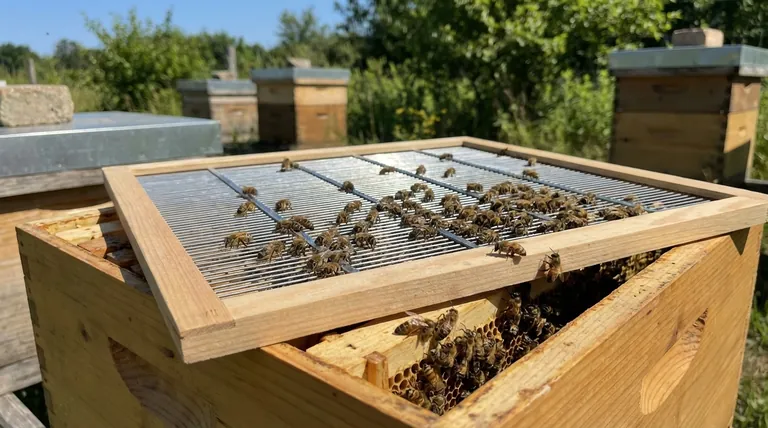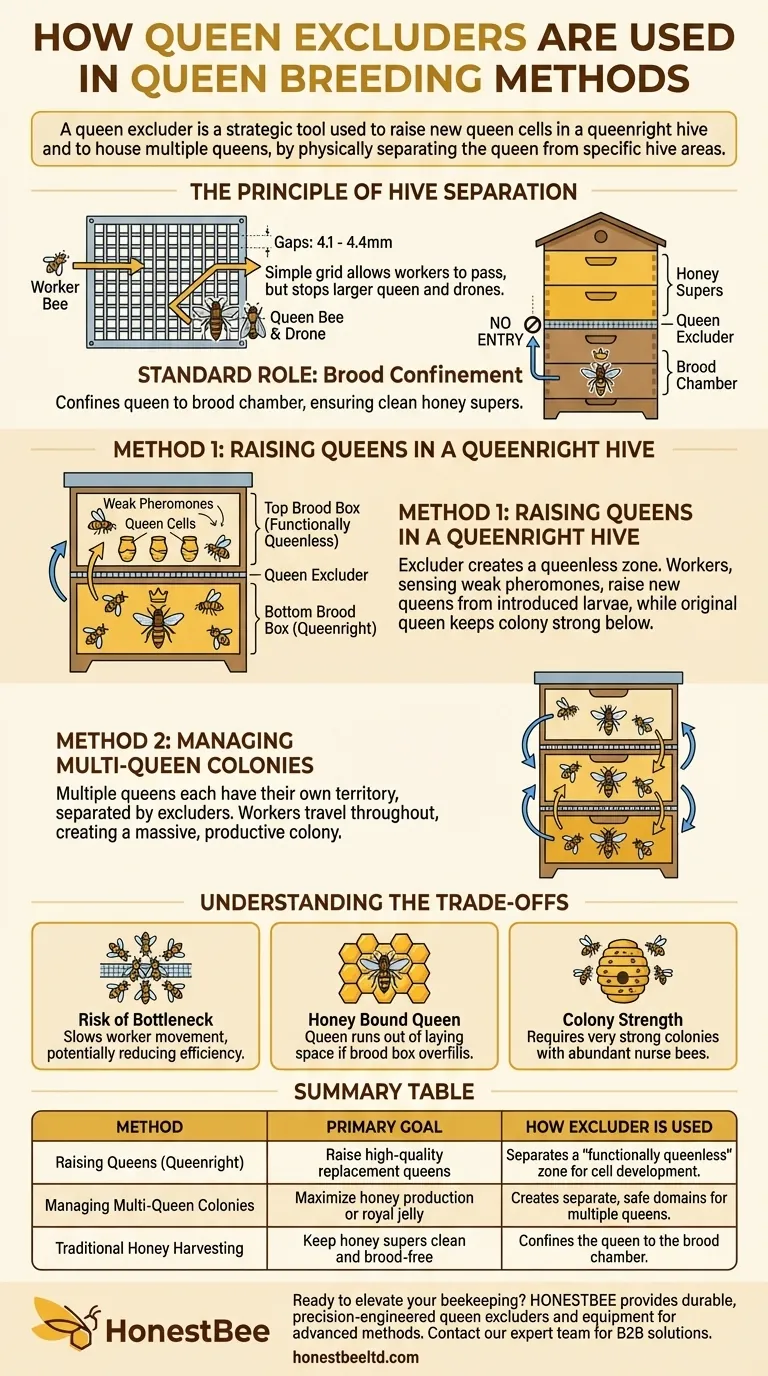In queen breeding, a queen excluder is a strategic tool used for two primary purposes: to raise new queen cells in a hive that already has a laying queen, and to house multiple queens within a single colony. It accomplishes this by physically separating the queen from a specific area of the hive, which manipulates the colony's natural instincts.
The core function of a queen excluder in breeding is not just containment, but controlled separation. It allows a beekeeper to create a "functionally queenless" zone within a strong, queenright hive, tricking the worker bees into raising new queens they would otherwise suppress.

The Principle of Hive Separation
What is a Queen Excluder?
A queen excluder is a simple grid, typically made of metal or plastic. The gaps in the grid are precisely sized—usually between 4.1 and 4.4 millimeters.
These gaps are large enough for smaller worker bees to pass through freely but too small for the larger queen and male drones.
Its Standard Role: Brood Confinement
In typical hive management, the excluder is placed between the lower brood boxes and the upper honey boxes (supers). This confines the queen to the brood chamber, preventing her from laying eggs in the honey supers.
This standard practice ensures honey is clean and free of brood, making harvesting far more efficient. The principles of this separation are adapted for more advanced queen breeding techniques.
Method 1: Raising Queens in a Queenright Hive
The Challenge: Suppressive Pheromones
A healthy, laying queen produces powerful pheromones that signal her presence throughout the hive. These pheromones inhibit the workers' instinct to create new queens.
To raise new queens, beekeepers must typically create a "queenless" hive, but this weakens the colony. Using an excluder bypasses this problem.
Creating a "Functionally Queenless" Zone
In this method, the beekeeper uses two brood boxes. The queen is confined to the bottom box with a queen excluder placed directly on top of it.
The top brood box is now physically separated from the queen. While worker bees can move between the boxes, the queen's pheromones are much weaker in this upper chamber. The workers in this zone behave as if they are queenless.
Initiating and Developing Queen Cells
The beekeeper can now introduce young, grafted larvae into this queenless upper box. Because the nurse bees in this area perceive a lack of a queen, they will begin feeding these selected larvae royal jelly, developing them into queen cells.
The key advantage is that the original queen continues laying in the bottom box, ensuring the colony remains strong, populous, and has plenty of nurse bees to raise high-quality new queens.
Method 2: Managing Multi-Queen Colonies
The Goal: Maximizing Population
A more advanced technique involves using queen excluders to manage multiple queens in a single, vertical hive. Queens are naturally territorial and will fight to the death.
Excluders prevent this by creating separate domains for each queen.
Structuring a Multi-Queen Hive
In this setup, a beekeeper might have a queen in a bottom brood box, followed by a queen excluder, then another brood box with a second queen, another excluder, and so on.
Each queen has her own territory to lay eggs in, but the worker bees can travel throughout the entire hive. The workers will tend to all queens and care for all the brood, creating a single, massive, and highly productive colony. This method is often used for maximizing honey production or producing royal jelly.
Understanding the Trade-offs
Risk of Creating a Bottleneck
The excluder can slow the movement of worker bees between different parts of the hive. This can sometimes reduce the efficiency of foraging and honey storage if not managed properly.
Potential for a "Honey Bound" Queen
If the brood box below the excluder becomes full of honey or pollen, the queen can run out of space to lay eggs. A vigilant beekeeper must ensure the queen always has adequate room.
Colony Strength is Non-Negotiable
These advanced methods only work with very strong, healthy, and populous colonies. A weaker colony does not have the resources—specifically, the thousands of nurse bees—required to feed and develop high-quality queens.
Making the Right Choice for Your Goal
To use a queen excluder effectively, you must first be clear about your objective.
- If your primary focus is raising a few high-quality replacement queens: The queenright cell builder method is the most reliable and effective approach.
- If your primary focus is maximum honey production or pollination: The multi-queen colony is a powerful but advanced strategy that requires significant management.
- If your primary focus is simply efficient and clean honey harvesting: Use the excluder in its traditional role to separate the brood chamber from the honey supers.
Ultimately, the queen excluder transforms from a simple barrier into a precise instrument for manipulating hive behavior to achieve specific breeding goals.
Summary Table:
| Method | Primary Goal | How the Excluder is Used |
|---|---|---|
| Raising Queens in a Queenright Hive | Raise high-quality replacement queens | Separates a "functionally queenless" zone for queen cell development from the main queen. |
| Managing Multi-Queen Colonies | Maximize honey production or royal jelly output | Creates separate, safe domains for multiple queens within one hive. |
| Traditional Honey Harvesting | Keep honey supers clean and brood-free | Confines the queen to the brood chamber below. |
Ready to elevate your beekeeping operation?
As a leading wholesale supplier to commercial apiaries and distributors, HONESTBEE provides the durable, precision-engineered queen excluders and equipment you need to implement these advanced breeding and production methods successfully.
Let us help you build stronger, more productive colonies. Contact our expert team today to discuss your specific needs and explore our full range of beekeeping supplies.
Visual Guide

Related Products
- Premium Wood Framed Metal Wire Queen Bee Excluder
- Professional Plastic Queen Excluder for Modern Beekeeping
- High Performance Plastic Queen Excluder for Beekeeping and Apiary Management
- No Grafting Queen Rearing Kit: System for Royal Jelly Production and Queen Rearing
- Lightweight Durable Plastic Queen Excluder Scraper for Beekeeping
People Also Ask
- What considerations should a beekeeper take into account when deciding whether to use an excluder?
- Can a queen get through a queen excluder? A Guide to Preventing Hive Failures
- When to put queen excluder on hive? Key Timing for Maximum Honey Production
- Where should a queen excluder be placed in a beehive? The Key to Hive Organization
- What are the advantages of using queen excluders? Boost Honey Production & Hive Management



















